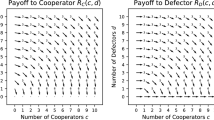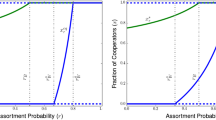Abstract
We consider the Stag Hunt in terms of Maynard Smith’s famous Haystack model. In the Stag Hunt, contrary to the Prisoner’s Dilemma, there is a cooperative equilibrium besides the equilibrium where every player defects. This implies that in the Haystack model, where a population is partitioned into groups, groups playing the cooperative equilibrium tend to grow faster than those at the non-cooperative equilibrium. We determine under what conditions this leads to the takeover of the population by cooperators. Moreover, we compare our results to the case of an unstructured population and to the case of the Prisoner’s Dilemma. Finally, we point to some implications our findings have for three distinct ideas: Ken Binmore’s group selection argument in favor of the evolution of efficient social contracts, Sewall Wright’s Shifting Balance theory, and the equilibrium selection problem of game theory.


Similar content being viewed by others
Notes
It is important to note at the outset that we will be considering a model of group selection that is completely Hamiltonian in spirit. We are not considering the cases where groups are treated as cohesive units that are in direct competition, but rather the effect of a certain kind of group-structure in the population (with correlated interactions) on the selection of individual social strategies.
In games with more strategies, risk dominance has to be defined differently.
It is important to also note that Binmore’s view on the equilibrium selection problem is much more nuanced than the quoted passage suggests. In particular Binmore argues that humans are especially good at solving equilibrium selection problems and that our fairness norms play an important role in how we solve these problems. However, for our purposes here, we will treat this as a stand-alone argument.
There are also some important differences between the two ideas. Wright’s shifting balance theory rests heavily on small populations being subject to greater genetic drift, whereas Binmore’s group selection argument simply depends on variation among which contracts are reached by different groups. The variation Binmore has in mind may have many possible sources.
Some may argue that the Haystack model is a poor model of group selection due to assumptions that are implausibly strong and not necessary. This may be true with respect to modeling the evolution of altruism, but, as we will discuss in the section "Discussion", the assumptions of the Haystack model are much more palatable in the case of the Stag Hunt.
With probability 1 − r individuals mate at random with a member of the population. r can also be interpreted as a simple correlation parameter representing the likelihood of mating with an individual of the same type where r = 0 represents purely random mating and r = 1 represents perfect correlation of types.
If a ≥ b + 1 we would still have a coordination game, but defection would no longer be risk-dominant. Consequently, it would be easier for cooperation to survive and increase in mixed groups. Depending on how we imagine the selection process with very small numbers, it may mean that mixed groups converge to the stag hunting equilibrium instead of the hare hunting equilibrium. However, achieving efficiency in this class of games is already more likely than not without the additional group structure, because the basin of attraction for stag hunting is larger than the one for hare hunting in this case.
To our knowledge this analysis has nowhere been published before.
Note that additional generations within the haystacks would be equivalent to increasing the a in the payoff matrix for purposes of calculating group contributions. This may then mean that a > b + 1, which would mean hare hunting is not risk-dominant.
Maynard Smith was skeptical of the significance of this condition, remarking that “this corresponds to the case in which the population is divided into more or less permanently isolated groups, which are periodically reduced to very small numbers, and which may either become extinct or split to give rise to two groups\(\ldots\)it is unlikely that species are often divided into a large number of small and completely isolated groups” (1146).
References
Binmore K (2005) Natural justice. Oxford University Press, Oxford
Calcott B (2008) The other cooperation problem: generating benefit. Biol Philos 23:179–203
Gavrilets S (2004) Fitness landscapes and the origin of species. Princeton University Press, Princeton
Kandori M, Mailath GJ, Rob R (1993) Learning, mutation, and long run equilibria in games. Econometrica 61:15–18
Maynard Smith J (1964) Group selection and kin selection. Nature 201:1145–1147
Maynard Smith J (1976) Group selection quarterly review of biology 51:277–283
Maynard Smith J, Price G (1973) The logic of animal conflict. Nature 246:1145–1147
Okasha S (2009) Evolution and the levels of selection. Oxford University Press, Oxford
Samuelson L (1998) Evolutionary games and equilibrium selection. MIT Press, Cambridge
Skyrms B (2004) The stag hunt and the evolution of social structure. Cambridge University Press, Cambridge
Sober E, Wilson DS (1998) Unto others. The evolution and psychology of unselfish behavior. Harvard University Press, Harvard
Wright S (1932) The roles of mutation, inbreeding, crossbreeding and selection in evolution. In: Proceedings of the sixth international congress of genetics 1:356–366
Young HP (1993) The evolution of conventions. Econometrica 61:57–84
Acknowledgments
We would like to thank Ken Binmore, Patrick Forber, James Marshall, Samir Okasha, and Kevin Zollman for many helpful comments and for discussing earlier versions of this paper.
Author information
Authors and Affiliations
Corresponding author
Rights and permissions
About this article
Cite this article
Huttegger, S.M., Smead, R. Efficient social contracts and group selection. Biol Philos 26, 517–531 (2011). https://doi.org/10.1007/s10539-011-9265-3
Received:
Accepted:
Published:
Issue Date:
DOI: https://doi.org/10.1007/s10539-011-9265-3




